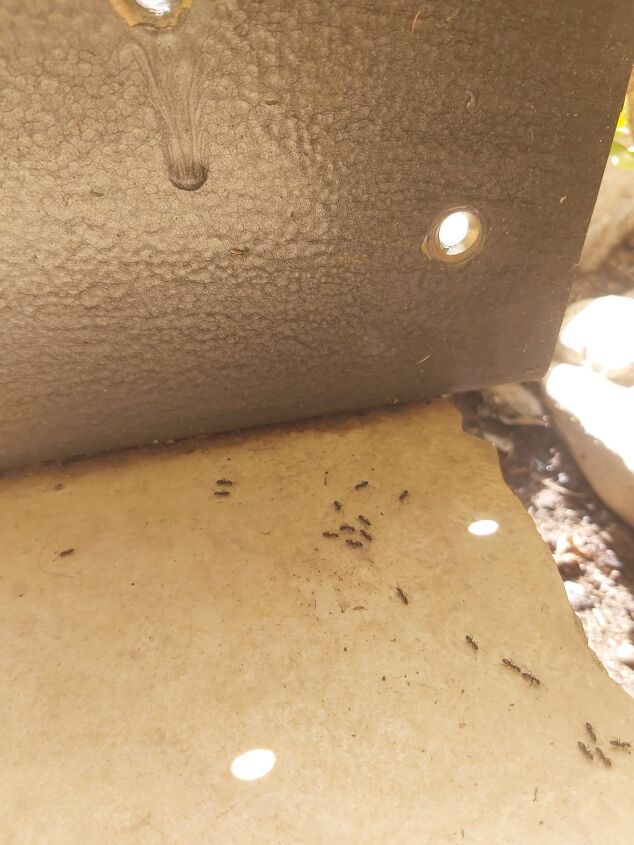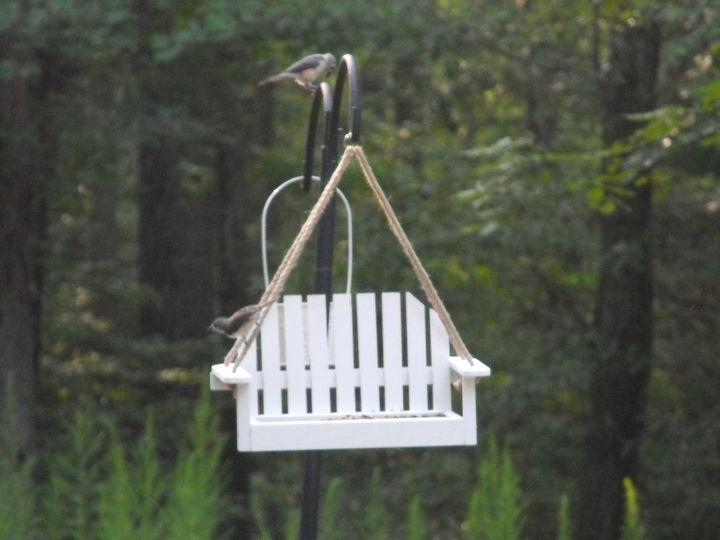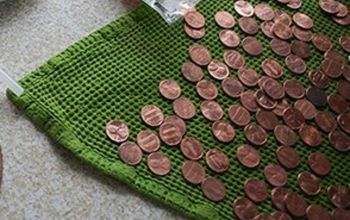Part of my back lawn, in full sun, dormant now due to lack of water and high heat.

-
Is this space irrigated? Any course you chose should take the upkeep in mind. As it would not make much sense to install $$$ patches of sod and have it all dry up and die in a few weeks.
 KMS Woodworks
on Jul 20, 2011
Helpful Reply
KMS Woodworks
on Jul 20, 2011
Helpful Reply -
-
You should use a tiller and turn the soil over and add good quality compost to the mixture to help soften the soil. This assumes you have more of a clay based topsoil already. But regardless of the type if you have had no rain and we have been dry as well in the NJ area or have not been watering the soil, then it will be hard and crack a lot. The difficult part is that once the soil gets that hard, it takes a lot of moisture for several days to soak back in and soften the ground. Sod can help, but you still need to till the ground so the roots of the sod will be accepted into the ground and continue to grow. And even if you have grass and it turns green that does not mean you have applied enough water to prevent it from dying out and going brown the next day. Try watering the soil every day for several hours. Quantity of water is critical but no so much that it runs off of the yard taking what top soil that is loose away with it. You may find watering several times per day rather then only once for a longer period of time will increase the soils ability to soak up what you apply rather then for it to simply wash away while little of it really soaks into the hard packed ground.
 Woodbridge Environmental Tiptophouse.com
on Jul 20, 2011
Helpful Reply
Woodbridge Environmental Tiptophouse.com
on Jul 20, 2011
Helpful Reply -
-
Correct me if I'm wrong but I'll assume you now have a cool weather grass. In the short term I would consider mulching the area with a hardwood mulch. It's tough to give up on grass but it looks like you'll be fighting a losing battle this time of year and it will keep the mud down once it rains. If grass is not growing well in that area anyway you might want to start over in the spring with an irrigation system, topsoil and sodding with a warm weather grass, perhaps bermuda or zoyzia.
 Joe Washington
on Jul 20, 2011
Helpful Reply
Joe Washington
on Jul 20, 2011
Helpful Reply -
-
Joe makes a good point about grass type. Sounds like you could have tall fescue, which is popular in coastal Virginia. If so, this is definitely not the time to plant, and unless you have irrigation you are always going to have a problem with it going dormant in the heat of summer. It is what tall fescue naturally does in response to the stress.
 Douglas Hunt
on Jul 21, 2011
Helpful Reply
Douglas Hunt
on Jul 21, 2011
Helpful Reply -
-
I would like the grass to stay green in winter. I do not mind it going dormant in summer heat, as it will green up again. I'm just having trouble getting it to grow thick and full, lots grass plants, but dirt spces in between. I'll probably end up doing the roto tilling, and mixing in compost.
 Clay B
on Jul 22, 2011
Helpful Reply
Clay B
on Jul 22, 2011
Helpful Reply -
-
The soil really holds the key. When it is good, the roots will grow deeply and you will see little of this type of problem. To quickly improve the soil you need microbes to build humus. To do this, find a nursery close to you that sells organic worm castings, which are rich in microbial activity. A couple of bags should suffice. Next get some sand and make a 50/50 mixture of sand with the worm castings. Now put in 10-15 lbs of 4-2-2 chicken manure, or an equal organic manure. We use bat guano, but this is difficult to obtain. Put a sprinker on the lawn early morning for an hour, then for an hour later in the day. Early the next morning aerate it well with a motorized or barrel type aerator. Take the mixture and apply as evenly as possible over the area. Now, get some molasses and put one or two tablespoons per gallon of water and apply a few gallons over the entire area with a sprayer. Then use the sprinkler once again for 30 minutes or longer. Water 30 minutes for several days. Now you have done a great job of rejuvenating your soil that will in turn, maximize root development. In the fall, re aerate and apply seed. An alternate method would be to till up the entire area and start from scratch.
 Peter's Natural Gardening
on Jul 22, 2011
Helpful Reply
Peter's Natural Gardening
on Jul 22, 2011
Helpful Reply -
-
You are correct in calling your grass "dormant". Fescue will go dormant in summer to survive the heat just as Bermuda grass goes dormant in Winter. As long as this period isn't too long, the grass will green up as the weather moderates. Aeration will allow water, air and compost to penetrate into the soil. Aeration is the best way to gain benefit from what little water is available. Tilling the soil will expose new weed seeds to the surface creating a new weed problem. Adding compost after aeration will build enzymes and add nutrients to the soil for improved grass health for years to come. Raking or "brushing " it in will minimize erosion.
 Travis P
on Jul 22, 2011
Helpful Reply
Travis P
on Jul 22, 2011
Helpful Reply -
-
Peter's Natural Gardening, thank you, but I've got to ask, what does the Molasses do?
 Clay B
on Jul 22, 2011
Helpful Reply
Clay B
on Jul 22, 2011
Helpful Reply -
-
Molasses is the most simple sugar. Because of this it is easily digested and eaten by the beneficial microbes to aid as a food source for energy and to increase reproduction. When synthetics are used they cause a rapid breakdown of soil structure, loss of carbon, and therefore a lack of necessary carbohydrates needed for healthy, humus rich soil. Humus is the organic form of carbon. Carbon is the basis for all life as we know it. If you look at the Peter's Natural Gardening website in the Links section, the thesis on Soil, Carbon and Climate is an excellent science based essay. Molasses also is a good source of Potassium. It is an extremely valuable all natural soil amendment.
 Peter's Natural Gardening
on Jul 23, 2011
Helpful Reply
Peter's Natural Gardening
on Jul 23, 2011
Helpful Reply -
-
Update: Aerating is the best thing I've ever done for my lawn. The hard to grow areas are doing much better, grass is thicker. Plus I don't have to water as much. I pay a lawn service to do the aerating in the fall. Not much more than renting. This last fall, I did aerating and seeding. It's going to look so much better this year, I can tell all ready. Some of the area's were very packed/dry soil from vehicles driven on it, swing-set etc., now soooo much better. Aerating is the way to go!
 Clay B
on Jan 29, 2013
Helpful Reply
Clay B
on Jan 29, 2013
Helpful Reply -
-
Good news.
 Douglas Hunt
on Jan 30, 2013
Helpful Reply
Douglas Hunt
on Jan 30, 2013
Helpful Reply -
Related Discussions
Creative uses for empty cat litter buckets, anyone?
Does anyone have any ideas of things to do with empty cat litter plastic buckets? I did take a foam square and covered the bucket and foam with fabric to make a quick... See more
How do you use washi tape?
Looking for ideas on how to use washi tape for DIY projects and crafts.Do you use it on notebooks, gift wrap, and journal pages?How about decor pieces and organizing ... See more
Is washi tape recyclable?
I'm moving to a new place and taking down my renter-friendly washi tape decor when I thought... wait, isn't this just paper? Can I chuck the washi paper in the recycl... See more
Can you write on washi tape?
I have some gorgeous translucent washi tape and I want to use it to label items. Has anybody written on washi tape before? If so, what type of pen/ink works best to s... See more
How effective are bay leaves for ants?
I'm dealing with a terrible ant infestation, and I heard that bay leaves can be a great way to keep them away. Do you know if that's true? If it is, how can I use bay... See more
Does anyone have any good suggestions on how to keep squirrels out of my bird feeders?
I have tried the crushed red pepper in the bird seed, and have tried putting vaseline on the pole that holds the feeders....any other suggestions? I will at times hav... See more
How to clean a mirror without streaks?
Every time I clean my mirrors, they end up having tons of streaks and almost look worse than before I started. What could I use to clean them that won't leave streaks... See more



